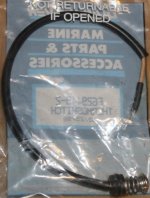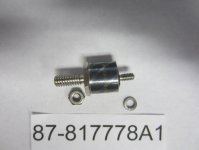The Force power
Commander
- Joined
- Feb 3, 2019
- Messages
- 2,359
Was there a lot of rust build-up caused by the key?.did the lapping procedure for the flywheel.















Was there a lot of rust build-up caused by the key?.did the lapping procedure for the flywheel.
No, there was no rust on the key or flywheel.....the rebuilt PH taper and key slot looked good too. Franz recommended the lapping and checking to make sure the tapers were making good contact. Probably overkill but now I know it fits right. Might help to prevent a sheared key.Was there a lot of rust build-up caused by the key?


Ok.......now, what if you used both of them.....I realize that if one goes off and the other doesn't, then the buzzer won't come on. But if the buzzer comes on....then you have 2 separate switches telling you that it is getting too hot? Not a good idea? Just thinking out loud here......You'll get the same results.
Sure, but don't hook them up in series because then a faulty one will not close the circuit (ground path)Ok.......now, what if you used both of them.....I realize that if one goes off and the other doesn't, then the buzzer won't come on. But if the buzzer comes on....then you have 2 separate switches telling you that it is getting too hot? Not a good idea? Just thinking out loud here......
Thanks Force P.....each switch would have it's own wire hooked into the terminal block for the overheat circuit. (orange). The old style switch uses an orange wire coming out of the harness....the new style has it's own wire that goes directly to the terminal block. Would this work? Even if one of them was faulty, as long as one activated and provided a ground path, then the buzzer would work, right?Sure, but don't hook them up in series because then a faulty one will not close the circuit (ground path)
You would have to split the wire & run one to each sensor
Yes, it willThanks Force P.....each switch would have it's own wire hooked into the terminal block for the overheat circuit. (orange). The old style switch uses an orange wire coming out of the harness....the new style has it's own wire that goes directly to the terminal block. Would this work? Even if one of them was faulty, as long as one activated and provided a ground path, then the buzzer would work, right?
Good to know, thanks!Yes, it will
Went ahead and tried out the heli coil kit I bought on that "hidden" bolt.....worked really well and put in a new SS bolt. LU is back on with new impeller and gasket.....will have to tweak on the gear shift rod a little to get it adjusted right, then see if she will fire up.The "hidden" bolt hole repair.
Just go the next size bolt.
Or get a longer bolt?? Or, Drill then tap and get a stainless bolt.
I agree.....just want to know what the comp is now since it is "new".....so can compare later as I put hours on it.If it starts easily? then I'd bet the comp is close.
I did the lapping racer.....since I was putting my old flywheel onto a rebuilt PH, just to be sure it fit right. After running for an hour, think I will check the torque on FW nut too.Lapping.-----Done with valve grinding compound on the flywheel and crank tapers.----Rotate them together to get a matched fit.------As you know the flywheel key locates the flywheel for proper ignition timing.----The flywheel is DRIVEN by the locking tapers.----Hence the importance of torque on the nut.